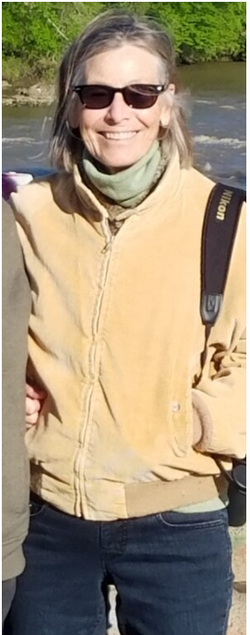 For the most part, Joanie McLean’s Every Single Thing (Wayfarer Books, 2021) touches on human and social relationships through absence and loss. A fine example is “Do You Know,” a poem addressing a dead friend who threw an annual Christmas party for the whole town. In the friend’s absence, the town carries on the tradition. As the poet carries the “little boy” of the dead friend through the crowd, she asks her friend: Could you see how everyone’s expression changed-- that shift around the eyes, the inhale—as they realized whom I held. The poet poses other questions to the dead friend, none ending in question marks, perhaps a signal that the questions are rhetorical: no response is expected, beyond the sharper sense of absence elicited by the question. Every Single Thing describes an aging and somewhat lonely existence—the loneliness partly a result of life events, partly a result of choices made. The communion with trees and animals is not shared with a larger human community. But a life so richly rooted in the life of field, stable, wood, and creek, is not bleak. For more on Joanie’s poetry, please consult her website (https://www.joaniemclean.com/). ******** Conclusion The poet alone speaking loud enough for others to overhear—this is the rhetorical situation of much modern lyric poetry since the Romantics. Reading Horace’s odes does not give me the same feeling. Though he lives on his farm in cultivated retirement, there are invitations, parties, poems of advice, descriptions of public events and shared historical experience. From my casual reading of his odes in translation, he is far from being “an ineffectual angel beating in the void his luminous wings in vain,” as Matthew Arnold described Shelley. In my own poetry, at times I have tried to write from a communal perspective, with mixed results at best. This is a topic I hope to return to in future posts.
0 Comments
 I first encountered McLean’s poetry in a poetry critique group. Over time I noticed her frequent use of personification. Every Single Thing (Wayfarer Books, 2021) has a number of interesting examples. “Drought” begins: The pond has gathered up its hems and retreated to its center. Less obviously, in the first stanza of “Snow Coming,” McLean writes: “The wind tests the tin roof, / tries the tack room door.” At the end of “Black Mingo Creek,” the poet is floating down the creek in a boat. She sees a coven of cotton mouths coiled on the mucky shore. …. I nod my respect towards the shore, "Evenin’ ma’ams.” McLean’s personifications arise naturally from her experience of nature, rather than as an arbitrary imposition of technique on experience. They grant an equality of being between the poet and the personified and allow the poet and her reader to “see into the life of things,” as Wordsworth describes it in “Tintern Abbey.” In “Abscission,” the technique helps us experience the falling leaves of autumn in a novel way. I urge you to read the poem for yourself. As a young poet, I dismissed personification as fusty and lazy, but in McLean’s hands it gracefully bears a heavy load of meaning, a genuine connection to the natural world. This is the first of what I hope will be several appreciations of poetry books and of individual poems, current and past. For the most part, my posts will not be formal reviews. They will offer praise and perhaps criticism, but I hope in a broad sense. For example, what are the limits of any particularly poetic style or practice? What expressive possibilities does a style or practice make available to us? Several questions lurk in the background of my posts, including this online comment by someone identified only as BDL on an essay by Margie Perloff in the Boston Review: “When was the last time a poet made a genuine contribution to the expressive power of the English language?” (posted 05/02/2012 at 03:47 as a comment on “Poetry on the Brink: Reinventing the Lyric” ). ******** Part 1 The poems in Every Single Thing (Wayfarer Books, 2021) come from McLean’s Buddhist practice. I know little about Buddhism, in theory or practice, but from McLean’s poems I gather that the practice involves close attention to the day-to-day experience of nature, work, and fellow humans. McLean trained as an ecologist and works as the owner of a native plant nursery that grows over 200 native species for water quality and conservation projects. She is one of my go-to people when I’m trying to identify a plant in my yard or neighborhood; her ability to name the plants and animals in her world give her poems a vivid authenticity. Her work and training and her attentive eye lend themselves beautifully to her spiritual practice and her poetry. For example, “Coyote Brings Dawn” is a stunning poem of observation and communion with the natural world. The coyote is beautiful—with “kohl-lined eyes and lips”—and unmistakable for any other animal: “side-winding hindquarters / syncopate his lope.” His behavior is, to this reader, at first surprising—“he slides a clump / a horse dung / out across” the crusty snow—and then sublime: “with neck and jaw / peach and white / of belly flash / he springs up” at the moment the sun clears the horizon. Communion, the term I used above, may inappropriately suggest a different religious tradition; although I’ve also taken it from a non-Buddhist tradition, perhaps participation would be better: poet and coyote participate in the same reality. Other poems provide the same sense, as in “Rabbit,” another account of breathtaking encounters with wild creatures, here a wood duck: “I saw its throat / quaver as it cried out, / its red eye fixed to mine.” Whatever the specific spirituality animating the poems, it has the effect of “pushing abstract ideas … down to the world of material practice” (Charles Inouye, “MI Podcast #127: ZION EARTH ZEN SKY”) . This is where poetry lives—in the names, the tactile and auditory textures, the cries, the pathos of shared existence. To comment on this post, please send an email to jsabsherphd at gmail.com.  Much of our political poetry probably belongs to a subsidiary type--party poetry, or poetry with a partisan edge. I prefer poetry with broader understanding, if not wider sympathies: “The Iliad, our oldest western epic, was designed as therapy for post-traumatic stress. It was written and recited to fulfill this role and it did so successfully. Simone Weil said that The Iliad is also the only epic in western history that doesn’t take sides between the two warring parties. It mourns the death of the Trojans as much as it does of the Achaeans, the Greeks. [Jonathan] Shay [in Achilles in Vietnam: Combat Trauma and the Undoing of Character, 1994] thinks that this may have been because it was performed for and in order to heal descendants of both sides. Shay’s point is that a culture that recited The Iliad orally, that had its combat veterans listening to The Iliad, was a culture that still thought that war is, as Simone Weil says, something that hurts not only the losers, but also the winners.”-- Timothy Patitsas, The Ethics of Beauty Achilles fighting against Memnon, Leiden Rijksmuseum voor Outheden (Jona Lendering, CC0, via Wikimedia Commons) |
AuthorWrite something about yourself. No need to be fancy, just an overview. Archives
July 2024
Categories |

 RSS Feed
RSS Feed